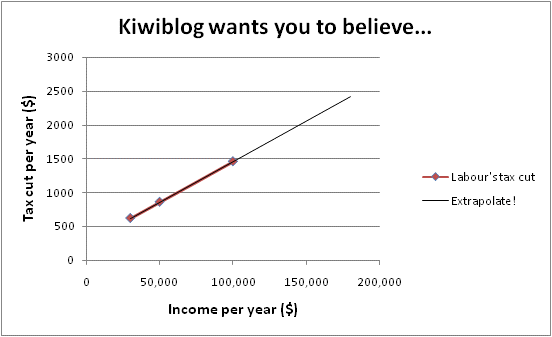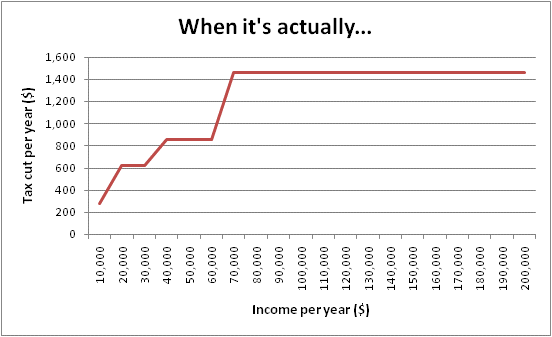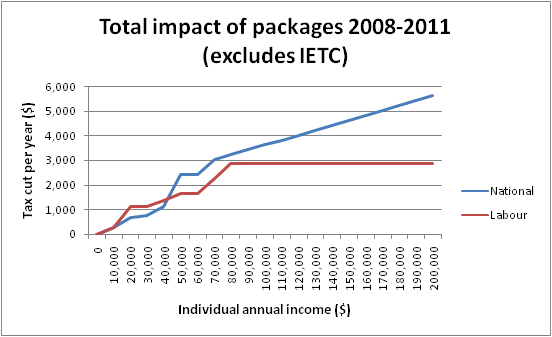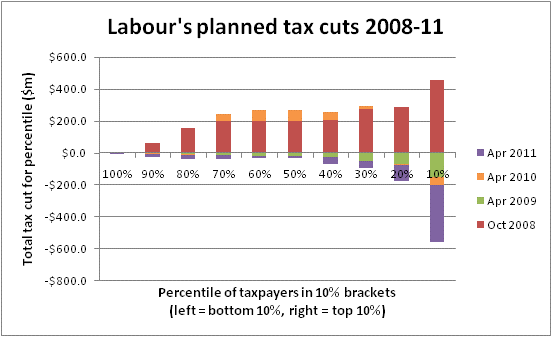I haven’t given nearly enough thought to the relationship between Farrar and the National Party comms machine, nor to the role that he plays in testing, seeding and propagating National Party messages. But it’s impossible to look at this indecent assault on numeracy and not think that it’s a lightly paraphrased briefing paper written by a policy-cum-comms hack (Research Unit?) outlining the key messages that National wants to get out ahead of the Budget.
The main thrust of it seems to be trying claim that Labour’s tax cuts are just as bad as National when it comes to favouring the rich. Here, DPF relies on one really straightforward trick: Picking sample points that distort the real picture.
He says that those on $30k get $620/year, those on $50k get $860/year, and those on $100k get $1460/year. So, the richer you are, the more you get, right? It implies a line that looks like this:

Well it’s not. It actually looks like:

It shows that a) Everyone earning $70k/year or more gets $1,460 in tax cuts – not just people earning $100k/year, and b) nobody gets more than that, regardless of income. Compare that with National’s tax cuts, which scales up with income.

But this is all meaningless information when we’re talking about the entire population, rather than one person. To understand how the package is structured and where the money is going, we need to incorporate data about who pays tax. So, here is one I prepared earlier, showing who would have benefited from Labour’s tax cuts:

Each bar represents 10% of taxpayers, sorted by income. The bottom 10% is on the left. The top 10% is on the right.
The parts below the axis represent tax increases – the effect of wage growth plus fiscal drag – you know, the stuff that the Right loved to talk about so much last year? Cullen’s tax cut was designed so that the increases to the upper threshold would be recovered (i.e. Back to what it was in 2008) by 2011.
By 2011, the middle 50% of taxpayers would have had the greatest net gain from tax cuts. Compare this with National’s tax cuts.

National April 2009 package was entirely weighed towards the top 30% of earners. The only thing that the next 20% get is Independent Earners Tax Credit – Treasury assumes that around half the taxpayers in that bracket are eligible. The bottom 50% get nothing from National at all, and will be paying more in tax every year.
The top 10% sees most of their tax cuts wiped out by wage growth and fiscal drag – but remember, the 2008 tax cut had already wiped it out, so National’s tax cut comes on top of that.
--
Their other line is that National’s tax cuts is a good response to the recession.
The New Zealand Institute’s latest report, Not just a case of a passing ‘Recessionary Flu’ doesn't beat around the bush on the issue:
…the next two tranches of the proposed income tax cuts should be cancelled on the grounds that they would contribute to the structural deficit, are unlikely to do much for growth, and do not support the most vulnerable households. Very few of the benefits of these proposed tax cuts flow to the most vulnerable families during the recession: most of the benefits accrue to upper-income households, and the cut that reaches furthest down the income scale (the proposed reduction of the 21 percent marginal tax rate to 20 percent) is not scheduled to take effect until April 2011. Nor are these tax cuts especially well-designed for growth creation, with the top marginal income tax rates left virtually unchanged (marginal income tax rates having significant incentive effects on individual work and production choices).”
Half the equation is that it’s just not very good at stimulating economic activity.
The other half is that a good stimulatory response is supposed to pump money into the economy as quickly as possible, then recover it when the economy is in better shape.
The next two phases of tax cuts does the exact opposite – it’s an arse-loaded stimulus package. The cost of cutting the top rate (in lost tax revenue) actually increases with time, but has the least stimulatory impact in the short-term. Delaying it will make it even more ridiculous, since the long-term cost stays the same, but its stimulatory value decreases further.
Instead of short-term, immediate spending, or even one-off tax refunds, National wants to implement tax cuts that actually become more expensive with time, and they wonder why there's a looming structural surplus?
This tax cut grew up in a more innocent time, when "Supersize Me Surplus" was a derisive term, when trying to get rid of the surplus was an actual, stated priority, when you had every editorial writer and columnist in the country backing you on it for no goddamn reason, and when you could actually get away with it.
It should go back there and die.
--
Kiwis should dismiss Michael Cullen's protestations that the surplus is not real." (John Key, 18 May 2006)